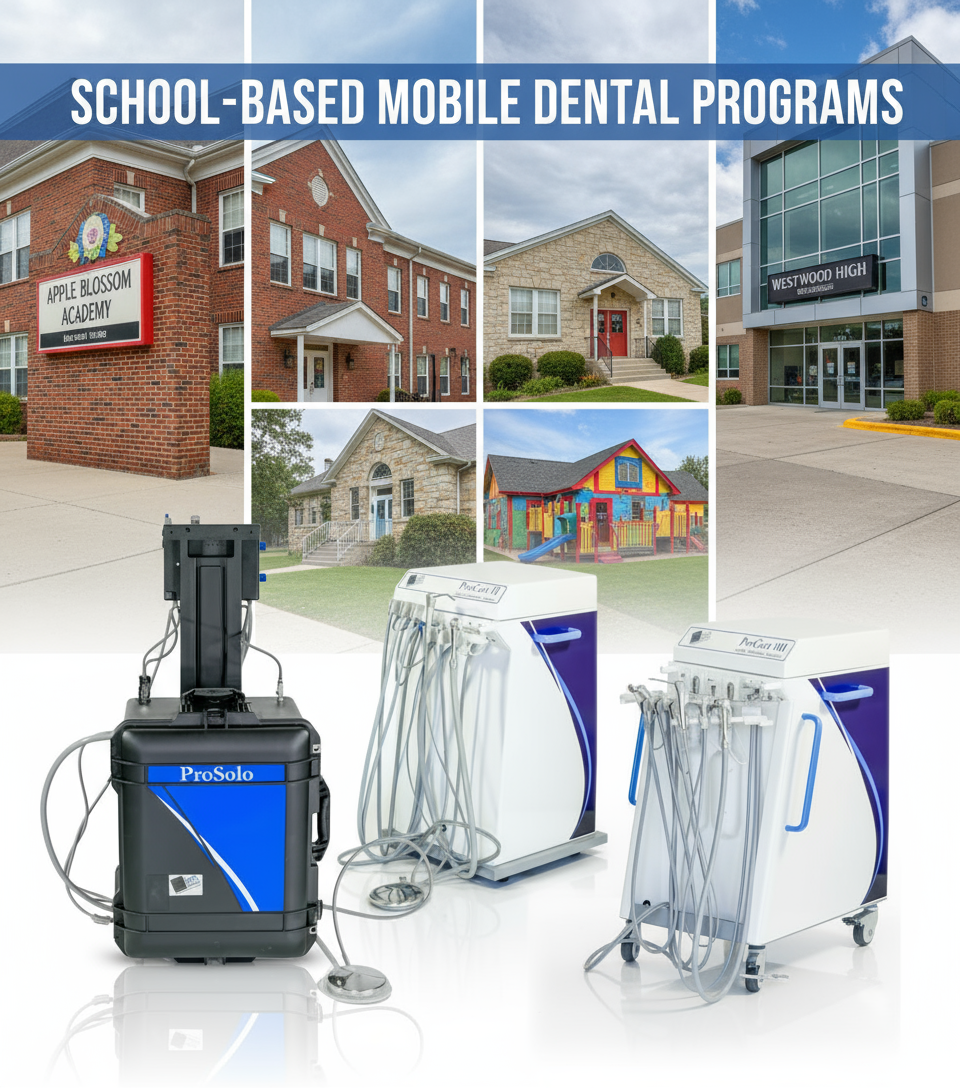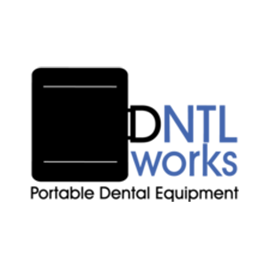
Share
The School-Based Dental Business Model Explained
Here's what makes school-based dental programs fundamentally different from traditional mobile dentistry—and why the economics are so attractive:
🎯 The Core Revenue Streams
1. Grant Funding (Year 1-2): $50K-300K
Covers startup costs: Equipment purchase ($15K-30K), initial supplies, staffing, marketing materials, and operating capital for first 6-12 months.
Key advantage: You're building a revenue-generating business with someone else's money. No business loans. No personal debt. No equity dilution.
Timeline: Grant applications take 3-6 months. Plan accordingly—apply for grants BEFORE quitting your day job.
2. Medicaid Reimbursement (Ongoing): $45-120 per student visit
The foundation of sustainable revenue. 37 million children qualify for Medicaid dental coverage. In Title I schools, 60-80% of students are Medicaid-eligible.
Typical preventive visit reimbursement:
- Exam (D0120/D0145): $15-35
- Cleaning/Prophylaxis (D1110/D1120): $25-55
- Fluoride varnish (D1206): $8-18
- Sealants per tooth (D1351): $15-35
Average revenue per student: $65-95 for exam + cleaning + fluoride. Add 4 sealants, and you're at $125-175 per visit.
3. School District Contracts (Optional): $5K-50K per school annually
Some school districts pay directly for services—especially for uninsured students or as part of wellness initiatives.
Typical contracts: Fixed monthly fee for X visits per month, or per-student fee for all students regardless of insurance status.
4. Private Pay/Insurance (Bonus Revenue): 10-20% of students
Not all students are Medicaid-eligible. Private insurance typically reimburses at higher rates than Medicaid.
Average private insurance reimbursement: $100-180 per preventive visit vs. $65-95 Medicaid.
The Business Model Advantage: Predictable Revenue at Scale
Here's what makes school-based programs different from traditional mobile dentistry:
Captive Audience
600-2,000 students per school, all in one location. No marketing. No patient acquisition costs. No-shows drop from 30% (private practice) to under 5% (school-based).
Predictable Cash Flow
Schedule 20-30 students per school day. Medicaid pays reliably. Know your monthly revenue within 5% accuracy. No seasonality (school year = 180 days of guaranteed work).
Low Overhead
No rent. No front desk staff. No office manager. Mobile equipment = $15K-30K. Compare to $350K-500K for traditional practice buildout.
Easy Scaling
One school = $80K-150K annual revenue. Add 2-3 more schools per unit = $250K-450K. Multi-unit operation with 5-10 schools = $1M+ revenue.
📊 The Quick Math: Single School Revenue Model
Elementary School Example: 800 students, 70% Medicaid-eligible
Year 1: Reach 40% of eligible students = 224 students
Average reimbursement: $85 per student (exam + cleaning + fluoride)
Additional sealants: 30% of students need 4 sealants @ $25/tooth = $100/student
Total Year 1 Revenue: $26,040 + (67 students × $100) = $32,740
Year 2+: Reach 60% of eligible students + recall visits
New patients: 336 students × $85 = $28,560
Recall visits: 224 Year 1 students × $65 recall = $14,560
Sealants Year 2: 100 students × $100 = $10,000
Total Year 2 Revenue: $53,120
That's ONE school. Now multiply by 3-5 schools per RDH or mobile unit.
The RDH Independence Path: Build Your Own Practice
This is the biggest opportunity for RDHs in a generation
For the first time in dental history, hygienists can build independent, profitable practices serving public health needs—without the overhead, politics, or revenue splits of traditional practice ownership.
Why This Works for RDHs (And Why It Hasn't Before)
The traditional path for hygienists who want independence has been... limited:
- Open your own practice? In most states, you can't own a traditional dental practice (dental practice acts require dentist ownership)
- Work as an independent contractor? You're still working in someone else's office, with their schedule, their patients, their systems
- Mobile hygiene for nursing homes? Low Medicaid reimbursement, irregular schedules, high travel time, compliance nightmares
School-based programs solve all of this. Here's how:
✅ Legal Independence
47 states allow RDHs to provide preventive services in schools under collaborative agreements or direct access. You're not practicing "under" a dentist—you're your own provider.
✅ Grant Funding Available
RDH-led programs qualify for the same grants as dentist-led programs. $50K-150K startup grants = no personal debt, no business loans.
✅ You Keep What You Earn
No practice owner taking 40-60%. Medicaid pays YOU directly. Your revenue is YOUR revenue (minus minimal overhead).
✅ Predictable Schedule
School hours = your hours. No evenings, no weekends. Summer off (or use for CE, vacation, or expand to other programs).
✅ Low Startup Costs
Mobile hygiene equipment: $6K-15K. Compare to $500K+ to buy into a dental practice or $350K+ to build out a traditional office.
✅ Massive Demand
Schools are SEEKING providers. 18 states mandate programs. No marketing needed—you're solving a problem school districts are desperate to fix.
💰 RDH Income Potential: The Real Numbers
Solo RDH, 3 Schools, Part-Time (20 hours/week during school year):
- Monday: School A (6 students × $85 = $510)
- Tuesday: School B (6 students × $85 = $510)
- Wednesday: School A (6 students × $85 = $510)
- Thursday: School C (6 students × $85 = $510)
- Friday: Alternating recall visits and new sealant patients
Weekly gross revenue: $2,000-2,500
36-week school year: $72K-90K gross revenue
Expenses (supplies, equipment maintenance, insurance, billing service): ~$18K-22K
Net Income Year 1: $50K-68K for 20 hours/week, 9 months
That's MORE than the average RDH salary ($77K/year, Bureau of Labor Statistics 2024)—working HALF the hours, with SUMMERS OFF, and YOU'RE THE BOSS.
Full-Time RDH, 5-6 Schools, or RDH with Assistant:
- Serve 12-15 students per day instead of 6
- Cover 5-6 schools with coordinated scheduling
- Hire a dental assistant to handle setup, breakdown, charting
Net Income Year 2-3: $120K-165K
For reference: Top 10% of RDHs in traditional practice earn $104K (BLS 2024). You'd be earning 15-60% more—while running your own show.
"But What About Dentist Supervision?"
Here's the reality: Most states don't require a dentist to be PRESENT for school-based preventive services.
Three Common Supervision Models for School-Based RDH Practice:
1. Direct Access (13 states)
No dentist required. You evaluate, treat, and bill independently. Colorado, Maine, Oregon, Washington, and 9 others allow full independent practice.
2. General Supervision / Collaborative Agreement (34 states)
A dentist signs a written agreement authorizing you to provide specified services. Dentist does NOT need to be present. You work independently day-to-day.
Typical arrangement: Consulting dentist reviews charts monthly, available for referrals, receives $500-1,500/month retainer or small percentage (5-10%) of revenue. You're still grossing 90-95% of revenue.
3. Direct Supervision Required (3 states)
Dentist must be physically present. This model doesn't work for school-based. If you're in one of these states, you'd need to partner with a dentist who travels with you—which dramatically changes the economics.
Bottom line: In 47 states, you can build an independent school-based hygiene practice. The collaborative agreement model (where applicable) typically costs you 5-10% of revenue—NOT 40-60% like working as an associate.
